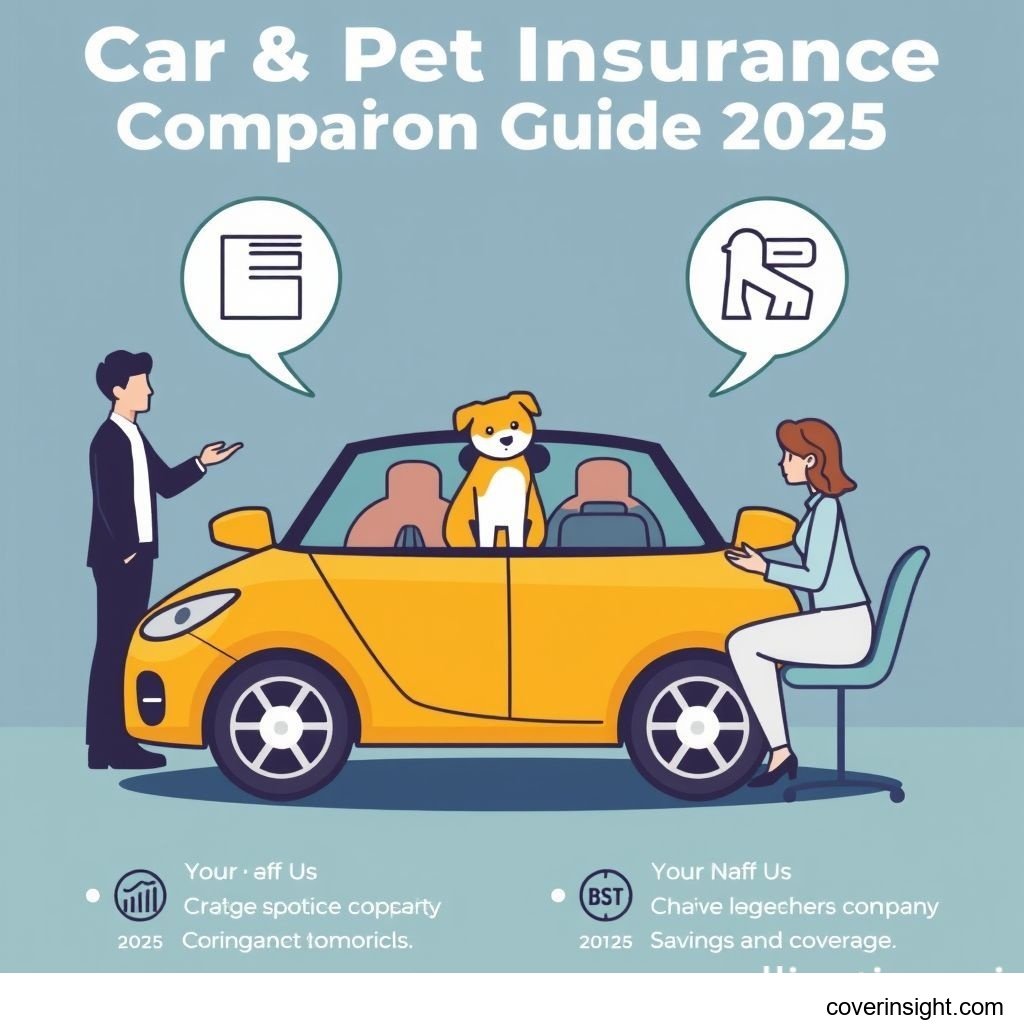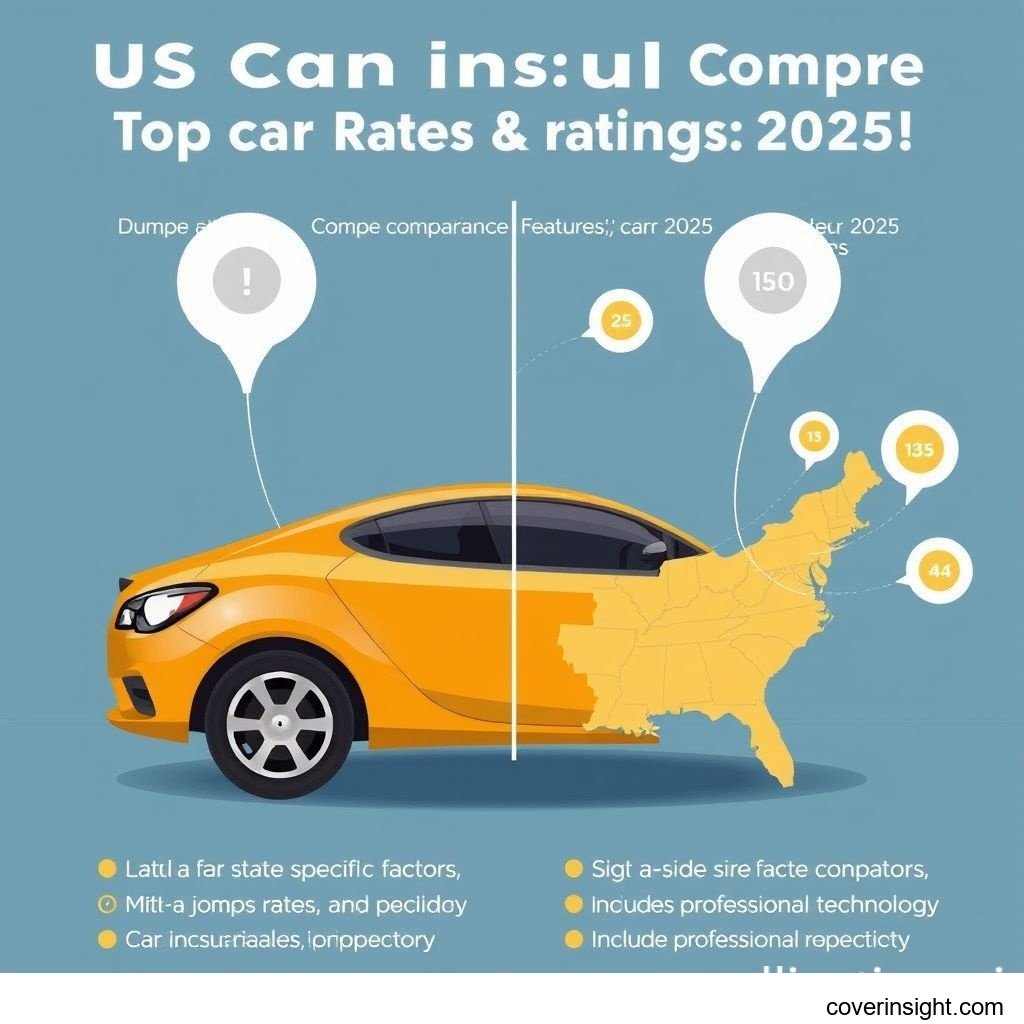Introduction
In the evolving landscape of 2025, navigating the complexities of insurance can feel daunting. For millions of Americans, securing adequate coverage for vehicles and beloved pets is a top financial priority. Understanding car insurance comparisons is no longer just a smart move; it’s an essential strategy for financial well-being and peace of mind. As premiums fluctuate and policy options diversify, a comprehensive comparison guide becomes invaluable. This article aims to equip you with the knowledge and tools to make informed decisions, ensuring you save big on your car and pet insurance policies in the US.
Car Insurance Comparisons: Coverage Details
When embarking on car insurance comparisons, a clear understanding of what policies include – and exclude – is paramount. Knowing the nuances can prevent unwelcome surprises down the road and ensure you’re adequately protected without overpaying.
What’s Included in Your Policy
Most standard car insurance policies in the US offer a combination of coverages designed to protect you, your vehicle, and others.
-
Liability Coverage: This is the most fundamental and often legally required type of coverage.
-
Bodily Injury Liability: Covers medical expenses and lost wages for others if you cause an accident.
-
Property Damage Liability: Pays for damage you cause to another person's property, such as their vehicle or fence.
-
-
Collision Coverage: Pays for damage to your own vehicle resulting from a collision with another car or object, regardless of fault. This is crucial for newer or higher-value vehicles.
-
Comprehensive Coverage: Protects your car from non-collision incidents.
-
Theft, vandalism, fire, natural disasters (hail, floods).
-
Falling objects, animal collisions.
-
-
Uninsured/Underinsured Motorist (UM/UIM) Coverage: Steps in if you're hit by a driver who has no insurance or insufficient insurance to cover your damages.
-
Personal Injury Protection (PIP) or Medical Payments (MedPay): Covers medical expenses for you and your passengers, regardless of who is at fault. PIP can also cover lost wages and essential services.
-
Optional Coverages:
-
Roadside Assistance: For flat tires, dead batteries, or towing.
-
Rental Car Reimbursement: Covers the cost of a rental car while your vehicle is being repaired after a covered claim.
-
Gap Insurance: For leased or financed vehicles, covering the difference between your car's actual cash value and what you still owe if it's totaled.
-
Common Exclusions to Watch For
While comprehensive, policies do have limitations. Being aware of these exclusions helps manage expectations during car insurance comparisons.
-
Intentional Damage: Deliberately causing damage to your vehicle is never covered.
-
Wear and Tear: Routine maintenance, mechanical breakdowns, or damage from normal use are not insurance claims.
-
Racing or Illegal Activities: Using your vehicle for racing or committing illegal acts voids coverage for related incidents.
-
Custom Equipment Not Declared: Aftermarket modifications or expensive custom parts might not be covered unless explicitly added to your policy.
-
Using Your Personal Vehicle for Ride-Sharing (Without Proper Endorsement): If you drive for Uber or Lyft, you need specific ride-sharing endorsements or commercial policies. Standard personal policies won't cover these activities.
-
Damage Beyond Policy Limits: Your policy will only pay up to the specified limits for each type of coverage.
-
Unlicensed Drivers: Allowing an unlicensed driver to operate your vehicle typically nullifies coverage in the event of an accident.
Cost Analysis of Car Insurance Comparisons
Understanding the factors that influence your premiums is key to effective car insurance comparisons. Prices can vary dramatically based on a multitude of personal and external elements.
Key Price Factors Influencing Premiums
Insurance companies assess risk based on several criteria to determine your premium.
-
Driving Record: A clean record with no accidents or traffic violations leads to lower premiums. Multiple tickets or at-fault accidents will significantly increase costs.
-
Vehicle Type: The make, model, year, and safety features of your car play a major role.
-
Sports cars or high-performance vehicles typically cost more to insure.
-
Cars with higher safety ratings or advanced safety features may qualify for discounts.
-
Vehicles prone to theft also tend to have higher comprehensive premiums.
-
-
Location: Where you live and primarily park your car influences rates. Urban areas with higher traffic density, crime rates, or extreme weather events usually have higher premiums.
-
Age and Gender: Younger, less experienced drivers (especially males under 25) often face higher rates due to statistical risk factors.
-
Credit Score: In many states, your credit-based insurance score is a significant factor. A higher score often indicates lower risk to insurers.
-
Coverage Limits and Deductibles: Choosing higher liability limits or lower deductibles will increase your premium, as the insurer takes on more risk.
-
Annual Mileage: Drivers who log fewer miles per year may qualify for low-mileage discounts.
-
Marital Status: Married individuals often receive slightly lower rates, statistically considered less risky.
Effective Saving Tips for Lower Rates
Even with rising costs, there are numerous strategies to save money on car insurance comparisons.
-
Shop Around Annually: Don't stick with the same insurer out of habit. Get quotes from multiple providers every year or two. Different companies weigh risk factors differently.
-
Bundle Policies: Many insurers offer discounts when you combine your car insurance with other policies, such as homeowners, renters, or even pet insurance.
-
Increase Your Deductible: Opting for a higher deductible on collision and comprehensive coverage can significantly lower your premium. Just ensure you can afford to pay that deductible if you file a claim.
-
Look for Discounts:
-
Good Driver/Safe Driver: For maintaining a clean driving record.
-
Good Student: For young drivers with good academic performance.
-
Multi-Car: For insuring multiple vehicles on one policy.
-
Anti-Theft Device: For cars equipped with alarms or tracking systems.
-
Loyalty: For long-term customers.
-
Payment Method: For paying in full or setting up automatic payments.
-
-
Improve Your Credit Score: As mentioned, a better credit score can lead to lower rates.
-
Consider Usage-Based Insurance (UBI): Programs like telematics devices track your driving habits (speed, braking, mileage) and can offer discounts for safe driving.
-
Drop Unnecessary Coverage: If you have an older, low-value car, consider dropping collision and comprehensive coverage. The cost of the premium might outweigh the potential payout.
-
Review Your Policy Regularly: Life changes (marriage, moving, children) can affect your rates. Regularly review your policy with your agent to ensure you have the right coverage at the best price.
Navigating State Insurance Market Guides
Understanding the local nuances is critical when performing car insurance comparisons. Each state in the US has its own regulations and market characteristics, which can significantly impact premiums and available coverage.
Understanding Local State Insurance Market Guides
State-specific rules dictate minimum coverage requirements, claim processes, and even how insurers can use factors like credit scores. For instance, some states are "no-fault" states, meaning your own insurance pays for your medical bills regardless of who caused the accident, while "at-fault" states require the at-fault driver's insurance to pay. Consulting your State Insurance Departments is always a good first step.
-
Mandatory Coverage: Every state mandates minimum liability insurance, but the specific limits vary widely. Some states also require UM/UIM or PIP.
-
Regulatory Environment: State insurance departments regulate rates, policy forms, and insurer practices. This oversight protects consumers but also shapes the competitive landscape.
-
Market Competition: States with many insurers typically offer more competitive rates. Fewer providers can sometimes lead to higher average premiums.
-
Geographic Risk Factors: State-specific risks, such as high rates of natural disasters (e.g., hurricanes in Florida, wildfires in California) or higher population density, influence overall state average premiums.
-
Unique State Programs: Some states offer specific programs or resources for consumers. The National Association of Insurance Commissioners provides valuable insights into state-level regulations and consumer assistance.
High-Risk Pool Options and Alternatives
For some drivers, finding affordable insurance through standard car insurance comparisons can be challenging. This typically applies to individuals categorized as "high-risk."
Specific Challenges in High-Risk Pool Options
Drivers often fall into the high-risk category due to:
-
Poor Driving Records: Multiple accidents, DUIs, or numerous traffic violations.
-
Lack of Driving History: Very new drivers or those with long lapses in coverage.
-
Specific Vehicle Types: Certain sports cars or highly customized vehicles.
-
Poor Credit History: In states where credit score is a factor.
When standard insurers decline coverage or quote exorbitant rates, high-risk drivers may need to explore alternative options. These typically come with higher premiums but ensure legal compliance.
-
Non-Standard Insurers: Companies specializing in high-risk policies. These insurers focus on providing coverage where standard companies fear to tread, often with higher rates but more flexible underwriting.
-
Assigned Risk Pools (Automobile Insurance Plans): In states where private insurers deny coverage, an assigned risk pool is a last-resort option. Drivers are "assigned" to an insurance company operating in the state, guaranteeing coverage at a regulated, albeit often higher, rate. This ensures everyone can get the legally required minimum coverage.
-
SR-22 or FR-44 Filings: These are certificates required by some states for high-risk drivers (e.g., after a DUI). They prove you have the required liability insurance and can significantly impact your rates.
-
Prepaid Car Insurance: Some non-standard insurers offer prepaid policies, which can sometimes be an option for those struggling with traditional payment structures.
While these options are pricier, they provide a pathway to coverage. Over time, maintaining a clean driving record can help you transition back to standard insurers and more favorable rates.
Comparing Pet Insurance Alongside Car Policies
While the primary focus is on car insurance comparisons, integrating pet insurance into your overall financial planning can lead to significant savings and peace of mind. Many insurers offer bundles or discounts when you combine multiple policy types.
The Importance of Annual Policy Reviews
Regular reviews of all your insurance policies are crucial. This applies to car, home, and pet insurance.
-
Life Changes: Marriage, a new home, a new pet, or a change in driving habits all warrant a policy review.
-
New Discounts: Insurers frequently update their discount offerings. You might qualify for new savings you didn't previously.
-
Coverage Adequacy: As your assets grow or your vehicle ages, your coverage needs may change. Ensure your liability limits are still appropriate, and consider if comprehensive/collision coverage is still cost-effective for an older car.
-
Price Updates: Premiums can change even without a claim. Shopping around annually for car insurance comparisons ensures you're always getting the most competitive rate.
Remember to consider resources like Insurance Resources Global, and for broader US-specific insights, visit US Insurance Home.
Frequently Asked Questions About Car Insurance Comparisons
Here are answers to common questions asked during car insurance comparisons.
How much does car insurance comparisons cost?
The cost of car insurance comparisons itself is free! You can get multiple quotes from various providers at no charge. The actual cost of car insurance, however, varies dramatically based on numerous factors like your driving record, location, vehicle type, and chosen coverage. Averages can range from $1,500 to $3,000 per year, but individual rates can be much lower or higher.
What affects premiums?
Several key factors affect premiums: your driving history (accidents, violations), the type of vehicle you drive, your age and gender, your location, your credit score (in most states), and the coverage limits and deductibles you select. Insurers also consider how much you drive annually and whether you qualify for specific discounts.
Is it mandatory?
Yes, in almost every U.S. state, car insurance is mandatory. Most states require drivers to carry at least minimum liability coverage to legally operate a vehicle. New Hampshire is the only state that does not mandate car insurance, but drivers must still prove financial responsibility.
How to choose?
When choosing car insurance after car insurance comparisons, consider these steps:
-
Assess Your Needs: Determine what type of coverage (liability, collision, comprehensive) and limits you need based on your assets and vehicle value.
-
Gather Quotes: Use online comparison tools or contact multiple insurers directly.
-
Compare Carefully: Look beyond just the premium. Compare coverage limits, deductibles, discounts, and customer service ratings.
-
Read Reviews: Check independent reviews of the insurer's claims process and customer satisfaction.
-
Understand Policy Terms: Make sure you fully understand what is and isn't covered.
Consequences of no coverage?
Driving without car insurance can lead to severe consequences, including:
-
Fines and penalties (often hundreds to thousands of dollars).
-
Suspension of your driver's license and vehicle registration.
-
Impoundment of your vehicle.
-
Inability to register your vehicle.
-
If you cause an accident, you will be personally responsible for all damages and medical bills, which could amount to tens or hundreds of thousands of dollars, potentially leading to lawsuits and financial ruin.
Image Alt Text: A magnifying glass hovering over a car insurance policy document, symbolizing car insurance comparisons. Image Alt Text: A diverse group of people reviewing insurance quotes on laptops and tablets, representing effective car insurance comparisons. Image Alt Text: A map of the United States highlighting different regions, emphasizing the importance of state insurance market guides.








Comments